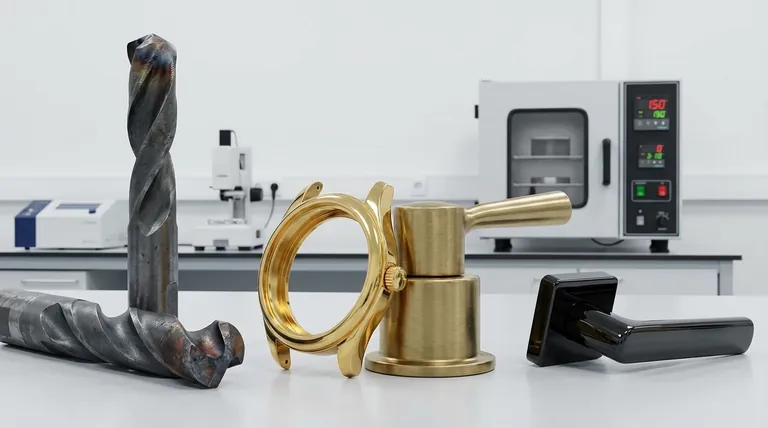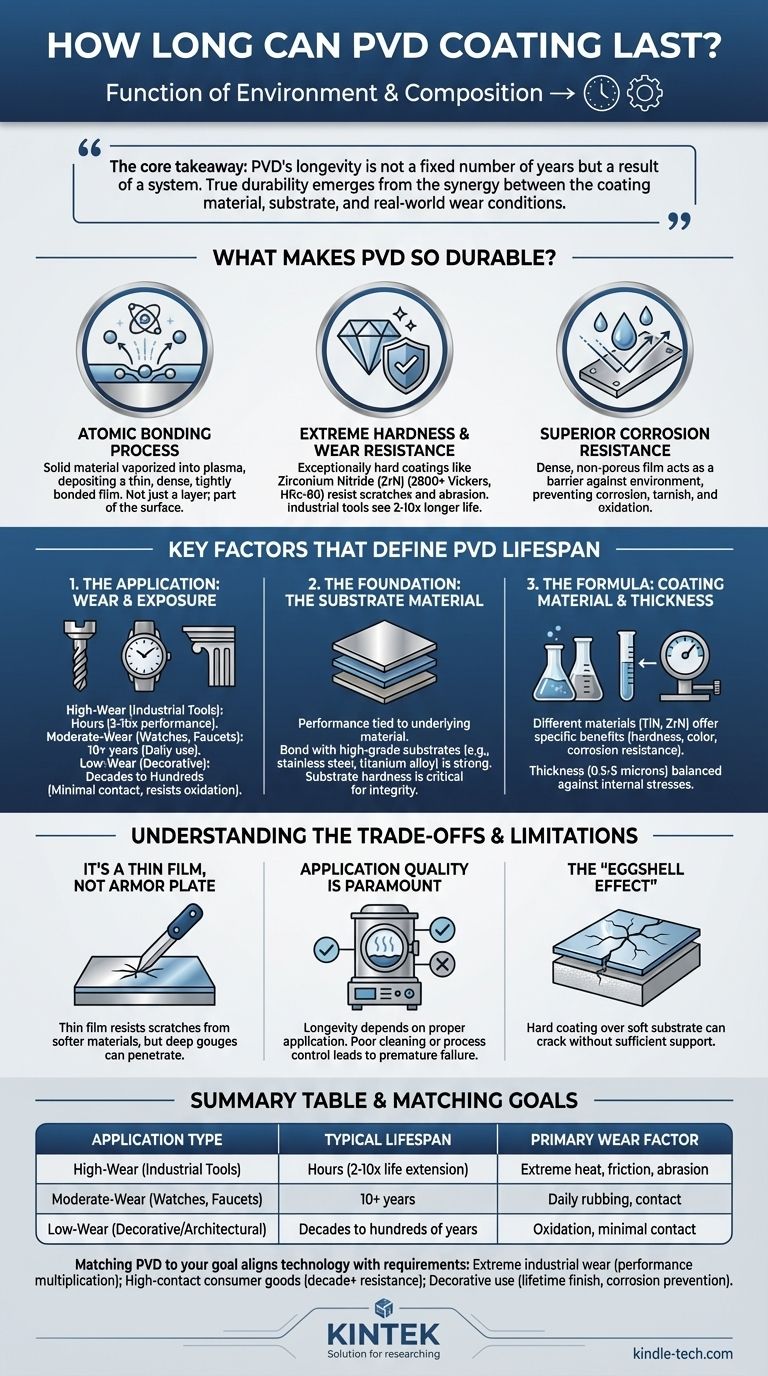The lifespan of a PVD coating is a function of its environment and composition. While it is not a simple question to answer with a single number, a well-applied PVD coating can last from a decade to a lifetime, depending entirely on its use. For high-wear industrial tools, its life is measured in a dramatic extension of operational hours, while for decorative items with low physical contact, the coating can easily outlast the object itself.
The core takeaway is that PVD's longevity is not a fixed number of years but a result of a system. True durability emerges from the synergy between the specific coating material, the substrate it is bonded to, and the real-world wear conditions it must endure.

What Makes PVD So Durable?
Physical Vapor Deposition (PVD) is not a layer of paint or plating; it is a surface modification process that creates an exceptionally strong, bonded finish. This durability comes from its unique application process and inherent material properties.
The Atomic Bonding Process
PVD is applied in a vacuum chamber where a solid material (like Titanium or Zirconium) is vaporized into a plasma of atoms. These atoms are then deposited onto the target object, forming a thin, dense, and tightly bonded film at a molecular level.
This process creates a finish that is part of the surface itself, rather than just a layer sitting on top of it. This is why it is highly resistant to flaking or peeling when applied correctly.
Extreme Hardness and Wear Resistance
PVD coatings are exceptionally hard. For example, Zirconium Nitride (ZrN), used for "Lifetime Brass" finishes, can have a hardness of over 2800 Vickers (HRc-80). This makes the surface highly resistant to the scratches and abrasion of daily use.
For industrial applications like cutting tools, this hardness translates directly to a longer operational life. A PVD-coated tool can see its lifespan increase by two to ten times compared to an uncoated equivalent.
Superior Corrosion Resistance
The PVD process creates a dense, non-porous film that acts as a powerful barrier against the environment. The coating is highly resistant to corrosion, tarnish, and oxidation from exposure to air, salt, and other chemicals.
Key Factors That Define PVD Lifespan
The vast range in potential lifespan—from ten years to hundreds—is determined by three critical variables. Understanding them is key to predicting performance for a specific application.
1. The Application: Wear and Exposure
This is the single most important factor. The environment the coating lives in dictates its longevity.
- High-Wear: A PVD-coated drill bit is subjected to extreme heat, friction, and abrasion. Its "life" is measured in a 2-10x increase in cutting performance, which may only be hours of continuous use, but this is a monumental improvement.
- Moderate-Wear: A watch case or kitchen faucet endures daily rubbing and contact. Here, a quality PVD finish can easily last 10+ years before showing significant wear.
- Low-Wear: An indoor architectural fixture or decorative trim sees almost no physical contact. In this scenario, the PVD coating can last for decades, potentially hundreds of years, as its main challenge is simply resisting oxidation.
2. The Foundation: The Substrate Material
PVD coating does not exist in a vacuum; its performance is tied to the material underneath it, known as the substrate. The bond between the coating and a high-grade material like stainless steel or titanium alloy is exceptionally strong.
The properties of the substrate, such as its own hardness and preparation, are critical. The coating relies on the substrate for its structural integrity.
3. The Formula: Coating Material and Thickness
Different PVD materials provide different benefits. Titanium Nitride (TiN) is a classic, all-purpose hard coating, while Zirconium Nitride (ZrN) offers superior corrosion resistance and a brass-like color.
Coating thickness, typically between 0.5 and 5 microns, is also a factor. However, thicker is not always better, as it must be balanced against internal stresses that could compromise the bond. The choice is a technical decision tailored to the end-use.
Understanding the Trade-offs and Limitations
To make an informed decision, you must recognize that PVD is not an invincible solution. Its incredible performance comes with specific trade-offs.
It's a Thin Film, Not Armor Plate
Despite its extreme hardness, a PVD coating is exceptionally thin. It will resist scratches from materials softer than itself, but a deep gouge from a sharp, hard object can penetrate the film and expose the substrate below.
Application Quality Is Paramount
The PVD process is highly technical. The longevity of the coating is entirely dependent on the quality of the application. Improper cleaning of the substrate or poor process control in the vacuum chamber will result in a weak bond, leading to premature failure like flaking or chipping.
The "Eggshell Effect"
Applying a very hard coating over a very soft substrate can be problematic. If the soft base material deforms under impact, the hard (but thin) PVD coating has no support and can crack—much like an eggshell on a sponge. The substrate's hardness must be sufficient to support the coating.
Matching PVD to Your Durability Goal
Use this framework to align the technology with your specific requirements.
- If your primary focus is extreme industrial wear (e.g., cutting tools): Judge PVD by its performance multiplication factor (e.g., 3x longer tool life), not by a duration in years.
- If your primary focus is high-contact consumer goods (e.g., faucets, watches, hardware): Expect a decade or more of excellent resistance to daily wear and tarnish, but understand that deep scratches are still possible under abuse.
- If your primary focus is decorative or architectural use (e.g., indoor fixtures): The coating can be considered a lifetime finish that will likely outlast the product it is applied to, with its primary role being tarnish and corrosion prevention.
By evaluating the specific demands of your application, you can specify a PVD coating that delivers predictable and exceptional long-term performance.
Summary Table:
| Application Type | Typical Lifespan | Primary Wear Factor |
|---|---|---|
| High-Wear (Industrial Tools) | Hours (2-10x life extension) | Extreme heat, friction, abrasion |
| Moderate-Wear (Watches, Faucets) | 10+ years | Daily rubbing, contact |
| Low-Wear (Decorative/Architectural) | Decades to hundreds of years | Oxidation, minimal contact |
Need a PVD coating solution tailored to your product's durability goals? At KINTEK, we specialize in advanced lab equipment and consumables for surface treatment applications. Our expertise ensures your coatings deliver maximum lifespan, whether for industrial tools, consumer goods, or architectural finishes. Contact us today to discuss how we can enhance your product's performance and longevity!
Visual Guide

Related Products
- Vacuum Heat Treat and Molybdenum Wire Sintering Furnace for Vacuum Sintering
- 2200 ℃ Graphite Vacuum Heat Treat Furnace
- High Pressure Laboratory Vacuum Tube Furnace Quartz Tubular Furnace
- Small Vacuum Heat Treat and Tungsten Wire Sintering Furnace
- Custom PTFE Teflon Parts Manufacturer for PTFE Tweezers
People Also Ask
- What is vacuum sintering? Achieve Unmatched Purity and Performance for Advanced Materials
- Where is vacuum furnace used? Essential for Aerospace, Medical, and High-Tech Manufacturing
- What are the advantages of vacuum sintering? Achieve Superior Purity, Strength, and Performance
- Does sintering use diffusion? The Atomic Mechanism for Building Stronger Materials
- What is the standard thickness of plating? Optimize Durability, Corrosion & Cost



















